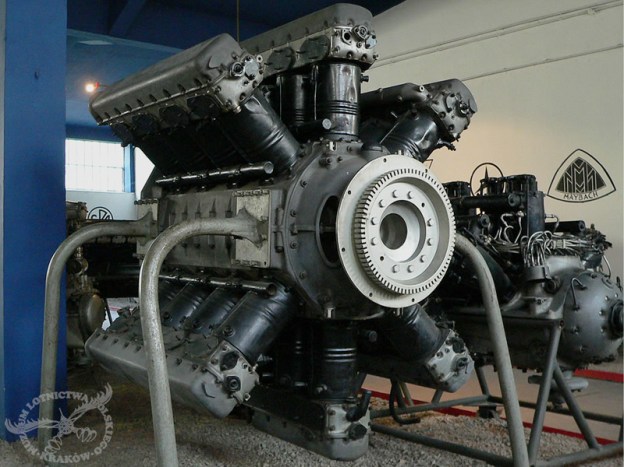By William Pearce
Following World War I, the Treaty of Versailles severely limited aircraft production in Germany; military aircraft could not be built or developed. Germany created the Department of Aviation within the Ministry of Transportation to oversee commercial aircraft. The Department of Aviation initiated development of a large, powerful engine to solely provide power for an equally large aircraft. This led to the Argus As 5—the company’s first post-World War I engine project.

The 24-cylinder Argus As 5. (Polish Aviation Museum Krakow image)
The Argus As 5 was a liquid-cooled, 24-cylinder engine with six banks of four cylinders. The cylinders were arranged in a double-W, or double broad arrow fashion. The top and bottom banks of cylinders had 45-degrees of separation from the bank on either side. The top set of three cylinder banks was separated by 90-degrees from the bottom set of three cylinder banks. All cylinders used a common crankshaft with a master and articulated connecting rod arrangement.
The As 5 had bore of 6.30 in (160 mm) and stroke of 7.68 in (195 mm). Total displacement was 5,742 cu in (94.1 L) and the engine had a compression ratio of 5.6 to 1. The As 5 developed 1,500 hp (1,120 kW) at 1,800 rpm and weighed 2,425 lb (1,100 kg). The As 5 used individual cylinders with welded steel water jackets. All the cylinders for a single bank shared a common aluminum head. Valves were actuated by a single overhead camshaft. The aluminum crankcase was separated into a top and bottom half.

Close-up view of the top three cylinder banks of the Argus As 5. (Stanislaw Guzik image)
After a few engine runs, the idea to power a large aircraft with a single large engine progressed no further, and the As 5 never took flight. Three Argus As 5 engines were built between 1924 and 1927. Development was abandoned partly because no aircraft could handle the engine’s immense size and weight. In addition, the German Ministry of Transportation decided that two smaller engines were more practical than a single large engine.
One of the three engines built still exists and is on display at the Polish Aviation Museum Krakow. The Argus As 5 is the largest engine in the museum’s aircraft engine collection.

Left view of the 1,500 hp Argus As 5. (Štepán Obrovský / Zdeněk Kussior image)
Sources:
– Argus – Flugmotoren und Mehr by Wulf Kisselmann (2012)
– Flugmotoren und Strahltriebwerke by von Gersdorff, Schubert, and Ebert (2007)
– Kolben-Flugmotoren by Hans Giger (1986)
– http://www.muzeumlotnictwa.pl/zbiory_sz.php?ido=115&w=a
– http://www.enginehistory.org/Museums/EasternEurope/EasternEurope.shtml


Wow that’s some engine a bit ungainly but pushing the envelope sometimes ends with some interesting results.
Also this is one of the finest websites for anyone interested in aircraft and aircraft engineering through the 20th Century Bravo and many thanks for the effort to share these miracles of design and engineering!
Regards,
Jason
Hello Jason.
Thank you for the kind words! Lots more to come.
Regards,
William Pearce
Veri good
An idea ahead of its time. Today the notion of a huge (powerful, that is), engine propelling a passenger plane is very strongly rooted. The Cessnas Caravans and Grand Caravans as well as the Quest are here to show that that is possible and even desirable.